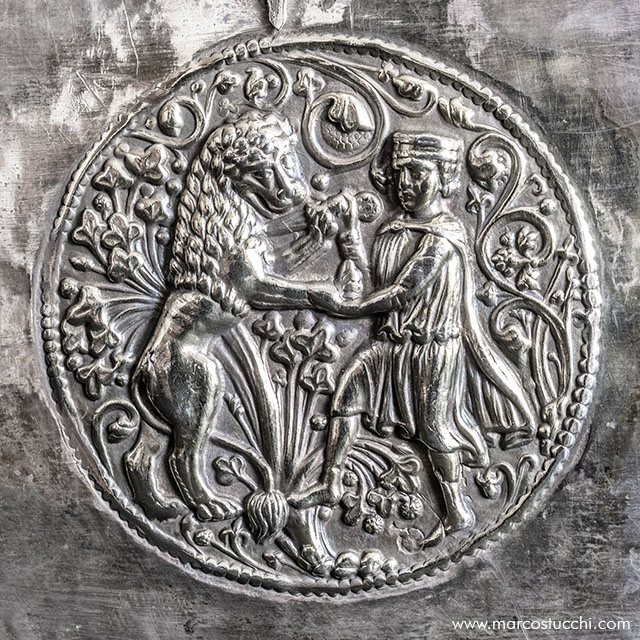
The Abbey’s Treasure
Versione italiana - Il Tesoro dell'Abbazia
We thank Dr. Carlo Tagliaferri for the precious collaboration.
The central part of the visit to the Benedictine and Diocesan Museum is represented by the Hall of The Abbey’s Treasure: a nucleus of precious artifacts of unmeasured religious and artistic value which today is a legacy of a time now far away in which the liturgy celebrated in the Basilica aimed at being almost tangible and to unveil the mysteries of faith. “The mind elevates to Truth through material things”, wrote Sugero, Abbot of the Saint Denis Monastery in France. Therefore these works of art that the visitors can see up close today in the protected environment of the museum, once – and still today in some moments of the liturgical year – served to make the Basilica more precious and to be used in sacred functions. Here are kept three staurothekes (note: early Christian relic holders) of the great relic of the wood of the Holy Cross: these are shaped as a Latin cross, with a double transverse beam, and as a Greek cross. In the treasure is kept as well an arm shaped reliquary with relics of Saint Sylvester I Pope, a silver box with relics of saints Senesio and Teopompo, and a small box made of ivory.
Small reliquary box of Saints Senesio and Teopompo
Provenance: Unknown. Materials: wood, partially gold plated silver lamina. Dating: end of XII – beginning of XIII centuryWooden box externally covered by silver lamina decorated with chiseling, partially gold plated and padded internally with drapes of red silk in order to contain the skulls of Saints Senesio and Teopompo.
The anterior part shows three arches resting on smooth columns surmounted by capitals with leaves under which are found an angel on a small cloud, a lion and an ox, both winged, symbols of the Evangelists Marc and Luke. An identical motif is repeated on the lid, on which instead are represented the symbols of an eagle and a winged man for the Evangelists Matthew and John.
In the back side and along the shorter sides four identical medallions are repeated, featuring the figure of a man fighting against a lion on a background of cut flourishing branches.
The decorative elements have a purely ornamental function as they are lacking any narrative intention, like that of any reference related to the stories of the lives or of the deaths of the saints whose bones are kept within.
Different hypotheses have been made about the dating of this work, spanning a chronological period included between the XI and the XIII century. The most significant stylistic comparisons can be recognized in some goldsmith work produced and stored in the territory of Veneto. These can be associated to the activity of shops that operated in the second half of 1200s.

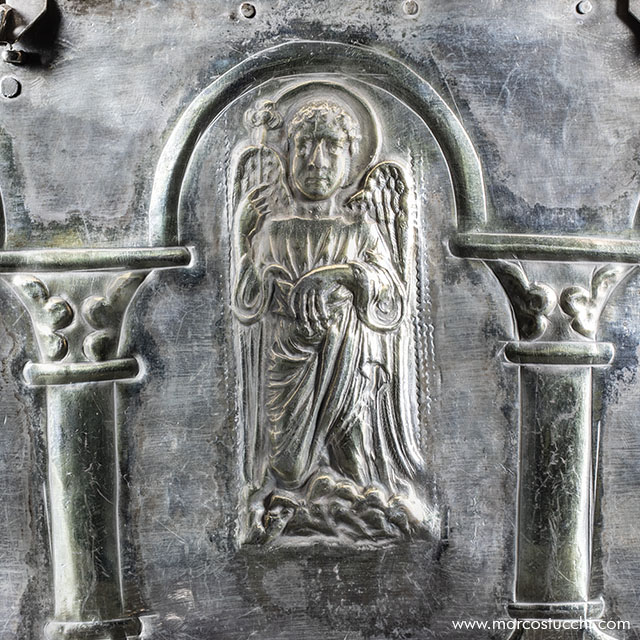
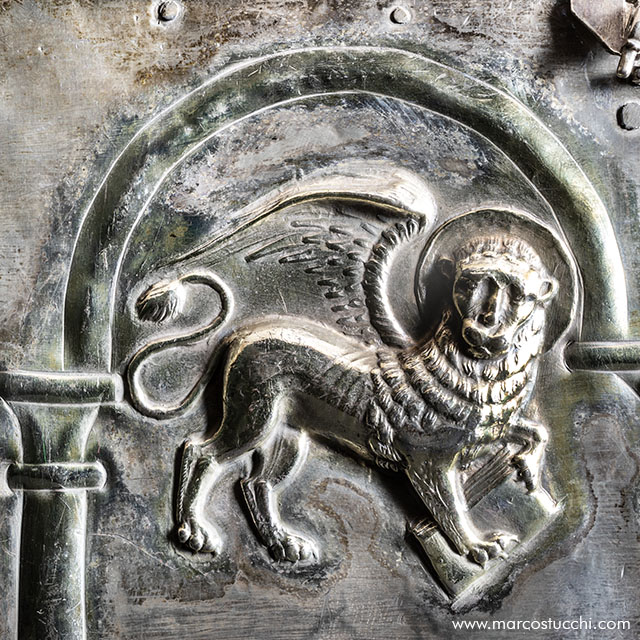
Ivory reliquary box
Provenance: unknown (Byzantium or Rhenish area). Materials: wood, ivory. Dating: end of XI – beginning XII century.
The small box simply shaped as a parallelepiped, is formed by a wood support on which are fastened small ivory engraved plaques that in part are perforated or colored with a red pigment. On the sides and on the cover, the same decorative motifs are repeated in various combinations and are combined so to form concentric frames.
In the inner part of the lid a strip of parchment from a later era bearing the inscription Vestimenta S. Stephani / Protomartiris (from the clothes of Saint Stephen / of the first martirs) is attached. Inside the box have been found fragments of bones and clothing in addition to a small glass ampoule, a small wooden stick covered in fabric, and a sachet to hold relics.
The reliquary is characterized by extreme decorative simplicity based on a strict geometrical repetition of single elements.
The rosettes or crosses formed by the grouping of small engraved concentric circles can be considered extremely simplified and stylized variations of the arabesque motif formed by palmettos and half palmettos combined, typical of the traditional decorative style of Islamic ivory artifacts. In these, though, usually the grouping of the decorations does not achieve the noteworthy intensity of repetition that is found in the specimen from Nonantola. Therefore, this can be considered both for the artistic sensibility and the technical achievement, much more similar to the ivory artifacts made in the Rhenish area at the end of the XI and beginning of the XII century.
During the Middle Ages, the Rhenish area and in particular the city of Koln, was characterized by a specifc development of the sumptuary arts and among these, ivory working reached levels of extraordinary quality.
Since the decorative apparatus here has a uniquely ornamental function and there are no specific references to biblical stories or to the lives of the saints, it cannot be excluded that this could be a case of an object which could have been originally created for profane use, like a jewel case or incense case, and then reused as reliquary, according to a custom which was widely attested during the Middle Ages.
Greek Cross Staurotheke (relic holder)
Provenance: unknown. Materials: wood, gold plated silver. Dating XIII – XIV century.
Small wooden table covered in a thin lamina made of gold plated silver bearing an opening in the center in which is placed a fragment of wood shaped as a Greek cross tied with gold plated silver strips in the point where the arms of the cross meet and at their extremities. The laminated metal leaves exposed some portions of the wood underneath it, forming a simple geometrical motif with squares and small triangles.
In its turn, the wooden table is contained into a larger table with a silver coated large border and a red fabric background on which there is a strip of parchment which was added in a later period, and on it, the words De Cruce S.cti Petri (from the cross of Saint Peter) can be read.
Such a typology of staurotheke (relic holders) is not commonly found, since the precious relics from the Holy Cross or those of the martyrs were the object of great veneration and were kept in more sumptuous reliquaries than this one. However, there are some exceptions, like the small relic holders belonging to the Treasure of the Basilica of Saint Marc of Venice that are very similar to the Nonantola specimen for structure and decor.
Such comparisons, together with the simple style of the artifact, suggest dating the work between the XIII and the beginning of the XIV century.
Though it is not mentioned specifically, most likely this cross is included in the group of crosses indicated as Item alia cruces incastratas (other encased crosses) made of silver that are accounted in the inventory of the possessions of the Abbey in 1331. In documents that followed in successive periods, this is always mentioned as Saint Peter’s cross.
Reliquary with the arm of Saint Sylvester
Provenance: Bologna. Materials: laminated silver, base in Egyptian porphyry stone. Dating: 1372.
The reliquary theca belongs to the typology of the so called talking reliquaries, which means that these were made with a structure that reproduces externally the shape of the relic that is contained inside. This is indeed a reliquary in the shape of an arm. On its top, the hand covered in a chiroteca (the bishop’s glove) shows the index and middle finger raised in the act of giving a blessing. On its back there is a decorated circular medallion representing the crucified Christ surrounded by two six pointed stars on the sides. Along the border of the fake glove, decorated to imitate embroidery, there is an engraved inscription that remembers the author of the work, the date it was made and the name of the Abbot that commissioned it. It reads: Hic argento clauditur brachium S. Silvestri Pape-De Bonis Sacristie Nonantulane tempore Venerabilis Patri set Domini Thoma de Marzapixis Civ. Bononiensis Decretorum Doctoris Anno MCCCLXXII-et Iullianus de Bonomia opus fecit. (This silver encloses the arm of Saint Sylvester Pope – from the goods of the sacristy of Nonantola the Venerable Father Don Thoma de Marzapixis, citizen of Bologna Doctor of Law ordered it made in the year 1372, and Giuliano of Bologna made the work).
It is accompanied by a large ring made more precious by colorful stones, perhaps donated by Gian Galeazzo Pepoli (1407-1449) to remedy to the loss of the two rings that decorated it originally as attested by a catalog of goods of the Abbey of 1398: ...brachium ...ornatum optime de argento cum duobus anullis... (an arm... decorated with excellent silver, with two rings…).
In the forearm there is an opening shaped with Gothic style protrusions, contoured with a thin engraved border and protected by a glass pane that allows one to see the relic inside. At the present, the arm is supported by a pedestal made of a precious porphyry stone cover onto which a silver ferrule is hooked and that in the past was used as a support for the Staurotheke of the Holy Cross, as the ancient inventory archives of the Abbey report.
The arm is used every year during the liturgy of December 31, solemnity of Saint Sylvester I Pope, patron of Nonantola.
Double arm staurotheke (relic holder) with portraits of Constantine and Helen
Double arm staurotheke (relic holder) with portraits of Constantine and Helen. Provenance: Byzantium. Materials: wood, golden glazed silver. Dating: end of XI – beginning of XII century.
The work is a rectangular shaped wooden tablet coated with a golden plated silver lamina in the anterior part, in which, in the central position, a double arm cross shaped indentation has been carved in order to contain a large portion of the relic of the Holy Cross (the second in the world for size), which is in turn surrounded by a gold plated silver border.
At the crossing point where the horizontal arm meets the vertical arm there are two small rectangular golden laminated foil plaques: the upper one has no decorations on it, while the lower one shows an image made with cloisonné enamel: it represents the Etimasia (the throne of Christ prepared for the end times) as stated in the Greek letter writing inscription on its sides. It shows a throne decorated with colorful drapes and a pillow on which the Book of Gospels and the Dove of the Holy Spirit are placed. Behind the dove there is a double arm cross, while on the sides stand a spear and a cane stick topped with a sponge immersed in vinegar, tools of the Passion of Christ.
In the top half of the wooden board, we find four chiseled half-body angels in the act of adoration and complaint. Below these are the figures of Emperor Constantine and his mother Helen, wearing a crown and a halo distinguished by their names chiseled on the side. At their feet, there is a piece of parchment that was inserted in a later period and bears the inscription De Cruce S.cti Andreae Apostoli (from the cross of Saint Andrew the Apostle).
The wooden table is enclosed in a glass case boarded with a chiseled silver frame, made in more recent times, while originally this was equipped with a cover made in laminated silver bearing the image of the Crucifixion with Mary, Saint John and two angels.
The style and composition of the work indicate that this is dating between the end of the XI and the beginning of the following century. This dating is confirmed by the confrontation of styles and typologies in similar works made in the same period and by the specific iconography rendering of the two imperial figures, showing analogies with those of the Byzantine rulers of that era.
Latin Cross Staurotheke (relic holder)
Provenance: Byzantium. Materials: wood, laminated gold coated silver, crystal, cloisonné enamel on gold base. Dating: the staurotheke dates from the end of the X century, the external case was added in 1679.
Staurotheke (early Christian relic holder) made of wood in the shape of a Latin cross, covered in gold plated laminated silver. In the anterior part a fragment of the relic of the Holy Cross is visible through a central opening also shaped as a cross. Along the arms of the cross are placed five small circular displaying cases that contain particles of several different relics. The posterior part is decorated with six golden medallions each representing a saint portrayed half body, made of cloisonné enamels. The six saints, of which for are warriors and two are healers, can be identified thanks to the presence of Greek language inscriptions near each figure. Starting from the top, we find Saint Sansone Ospitaliere (a medical doctor), Saint Damiano, Saint Nestore, Saint Artemio, while in the horizontal stretch of the arms are represented Saint Mercurio and Saint Procopio – all these are saints venerated in the Eastern Church starting from the X century.
The choice to represent only saints who were healers or warriors can be explained in the light of the salvation and healing power of the wood of the True Holy Cross, from which derive health and strength against evil, qualities testified by these two types of saints in the world. Moreover, they act as defenders and protect the precious relic that is contained within.
In spite of the small dimensions of the medallions, the images are detailed with noteworthy accuracy.
All the elements together allow us to consider the Nonantola cross an artistic artifact of great value, probably originally from Constantinople and dating from the end of the X century or the first decades of the following century. The staurotheke (relic holder) is used still today during liturgy: on Holy Friday it is carried in procession along the streets of the historical center of town and on September 14 , feast of the Exalting of the Holy Cross, it is brought to the Basilica for a solemn celebration presided by the Archbishop Abbot.
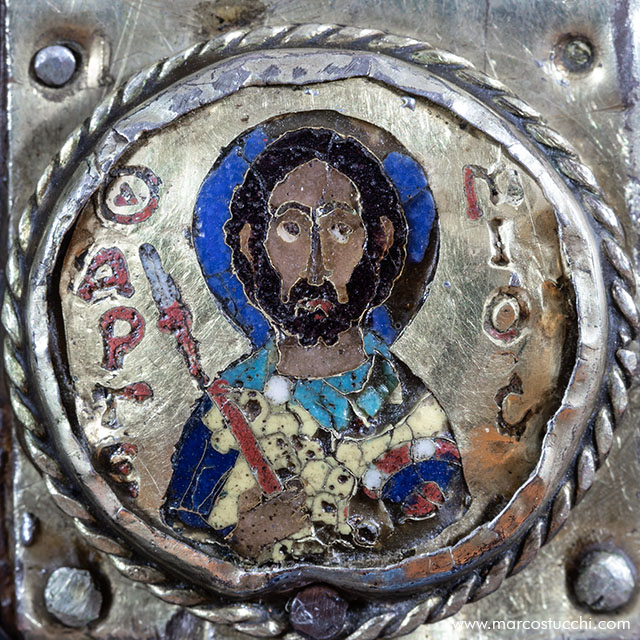
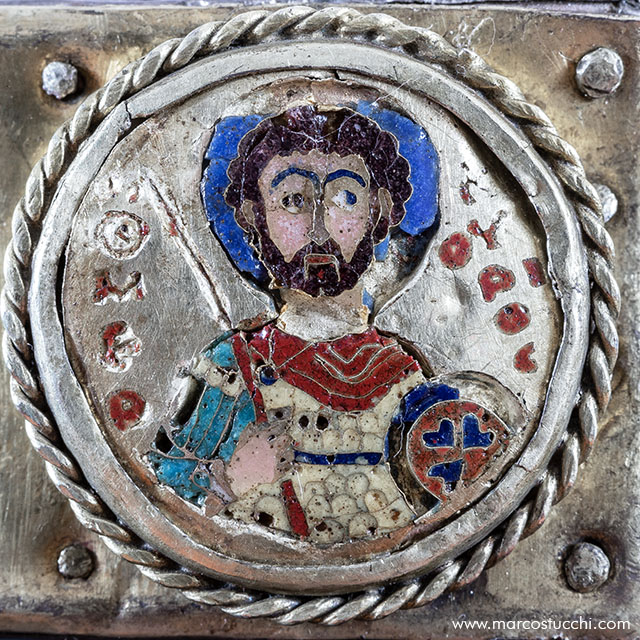
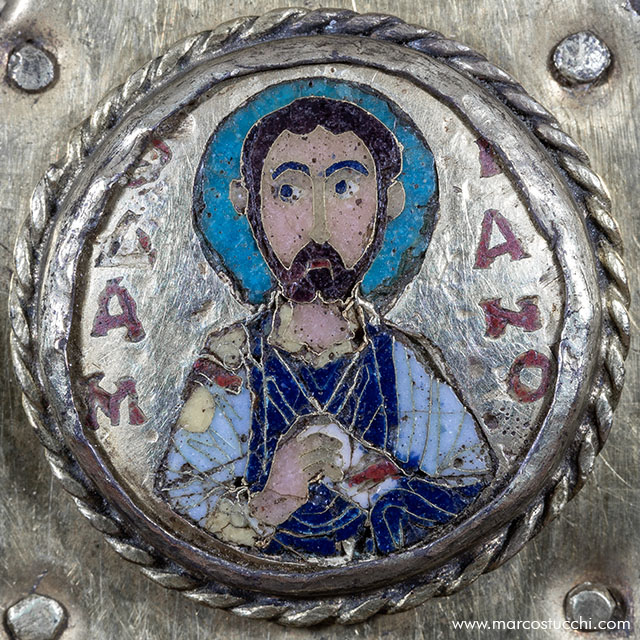
Polyptych
Polyptych of the Virgin enthroned with the Child, the Crucifixion and Saints
Tempera on wood; cm. 240x290
Commissioned in 1436 by the last regular abbot of the monastery, Gian Galeazzo Pepoli from Bologna (his coat of arms is on the plinth of the right steeple), the polyptych came to Nonantola only in 1460 when Gurone d'Este was already commendatory Abbot (his coat of arms is on the left plinth). It was placed on the altar of the central apse until the final decades of the XVI century, when it was moved to the sacristy to be replaced with the marble ark of Saint Silvestro. In the following centuries the polyptych was moved to various locations, until the year 2001 when it was finally located in the Diocesan Museum.
The author of the work is Michele di Matteo Lambertini, a painter well documented in Bologna starting from 1410. He was trained to the style of Giovanni da Modena and distinguished himself from his master by bringing innovation to local Gothic art thanks to his contacts with the Venetian environment.
Starting from the upper register, from left to right, on the polyptych are represented the following saints: John the Baptist, the Archangel Michael, the Apostle Peter, the Crucifixion with Mary and John the Evangelist, the Apostle Paul, Saint Lucia, Saint Anselmo (founder and first abbot of the monastery), Saint Bernard, Saint Martino, Saint Silvestro I Pope (patron of Nonantola), the Virgin enthroned with Child, Pope Adrian III (buried in the basilica), Saint Benedict and Saint Scolastica. In addition to benedictine saints, the presence of other saints is due to the existence of their veneration in the chapels of the Abbey or in churches that were connected to it, like the Pieve of Nonantola of Saint Michael the Archangel. In the dais is represented the Deposition of Christ surrounded by the Apostles dialoguing two by two.
San Carlo Borromeo battezza un neonato durante la peste
Ludovico Carracci (Bologna, 1555 – 1619)
Olio su tela; cm. 265x202
Madonna con il Bambino che consegna il rosario a San Domenico, Santa Caterina e misteri del Rosario
Elisabetta Sirani (Bologna, 1638 - 1665)
Coscogno, chiesa parrocchiale di Sant'Apollinare
Olio su tela; cm. 208x143
Ascension of Christ to Heaven
Master of the “Opened Eyes” (Ferrara, active around 1470)
Third quarter of the XV century
Ascension of Christ to Heaven - Tempera painting on wood; cm. 217x182
The large wood panel dating from the mid XV century has been attributed to the “Master of the Opened Eyes”, an anonymous artist from Ferrara belonging to the circle of Cosmè Tura, active at Palazzo Schifanoia of Ferrara together with Ercole De’ Roberti and Francesco del Cossa.
The altarpiece still has its original frame on which are engraved the first verses of the “Ave Maris Stella” hymn, an ancient prayer to the Virgin Mary dating from the VIII – IX centuries.
The work was probably commissioned to be exposed in the crypt of the Abbey on the occasion of its reopening to liturgical cult, but this did not happen since a few years later the crypt was filled in. The painting was forgotten and left in an underground tunnel where it underwent severe damage that is still visible today. At the beginning of the 1900s it was even proposed to be sold in order to finance the restoration of the Basilica.
The scene with Christ ascending to heaven surrounded and accompanied by angels rejoicing is set in a luminous and suggestive marine landscape in which the presence of a city with towers and surrounded by mountains in the distance can be noticed. In the foreground, the Virgin and the Apostles look on the event in awe.